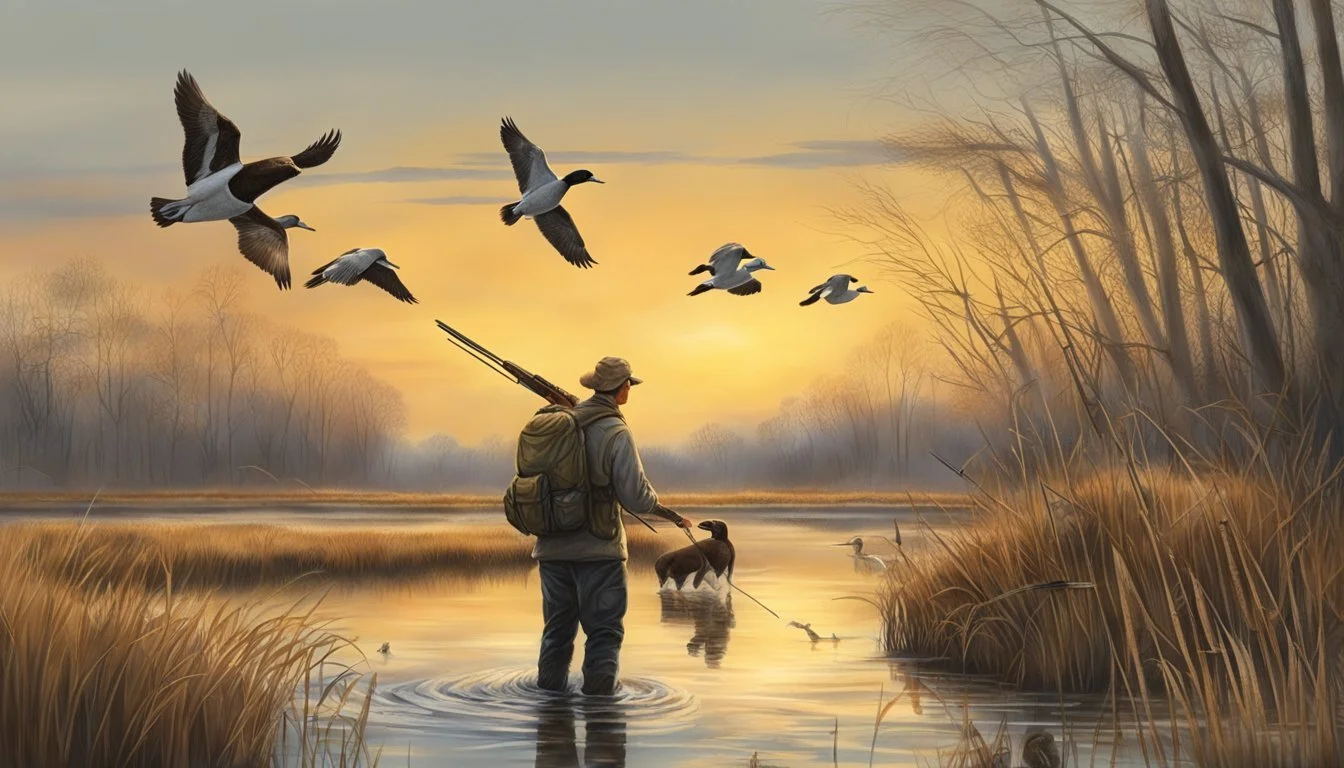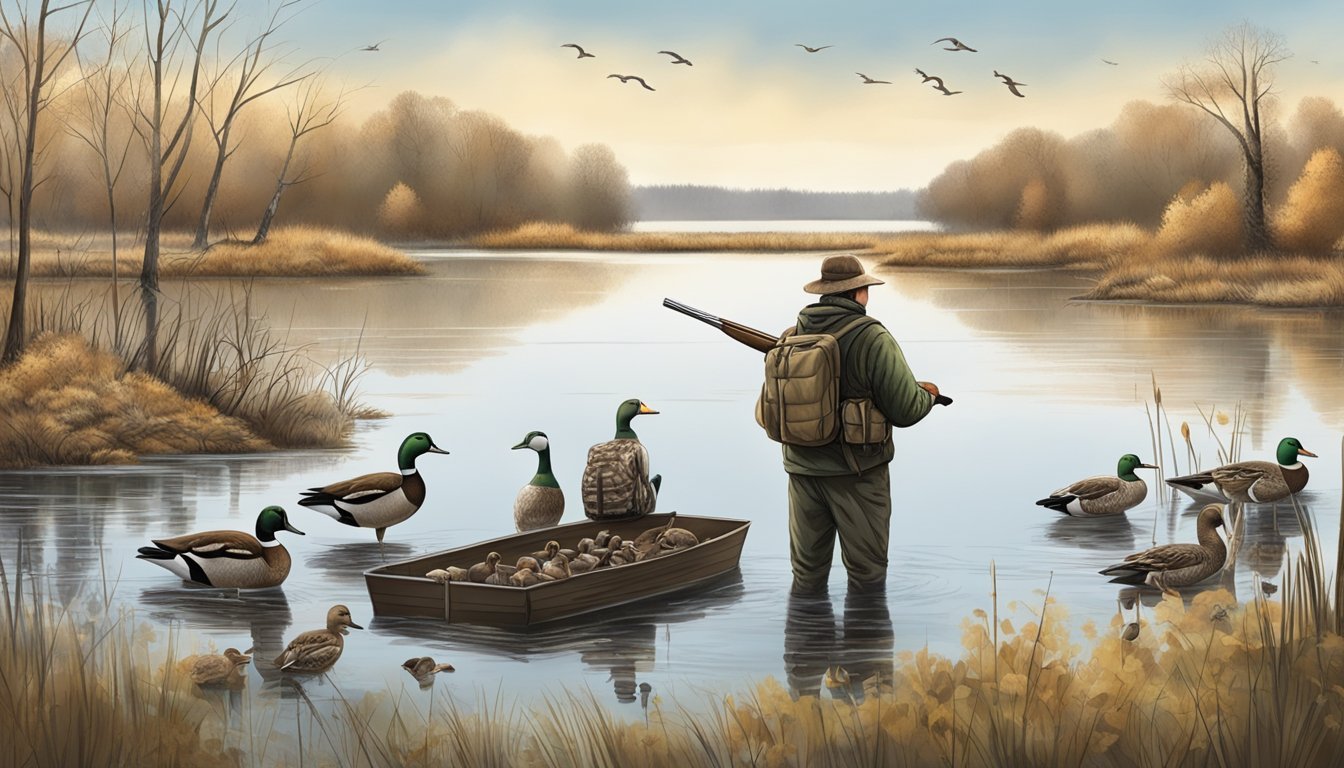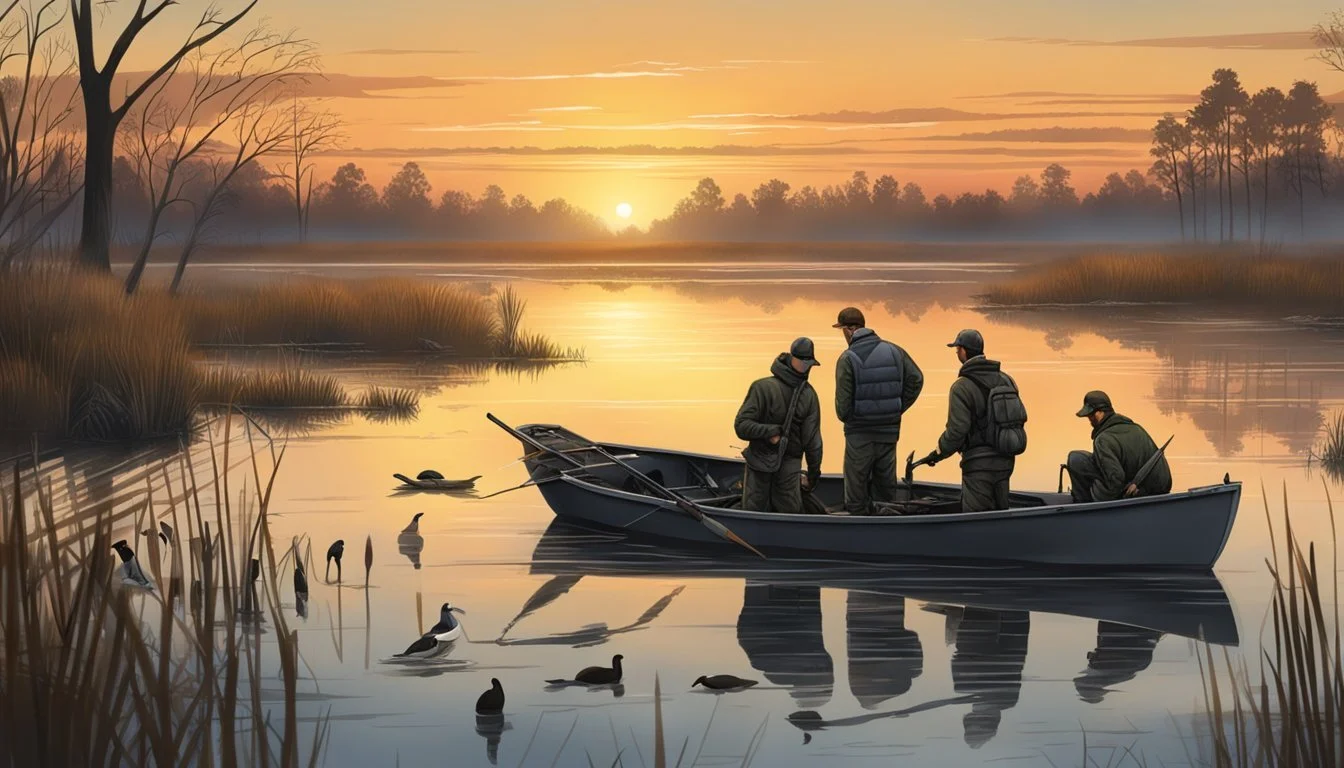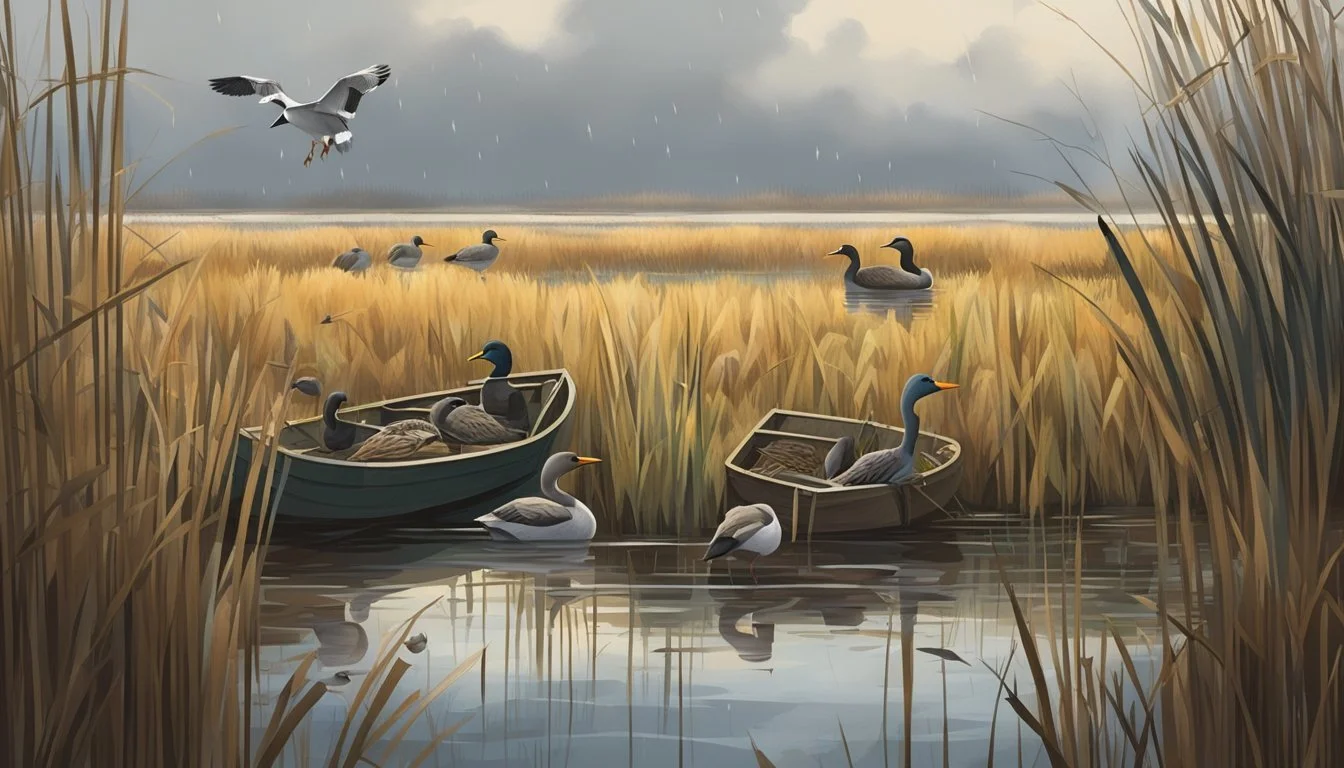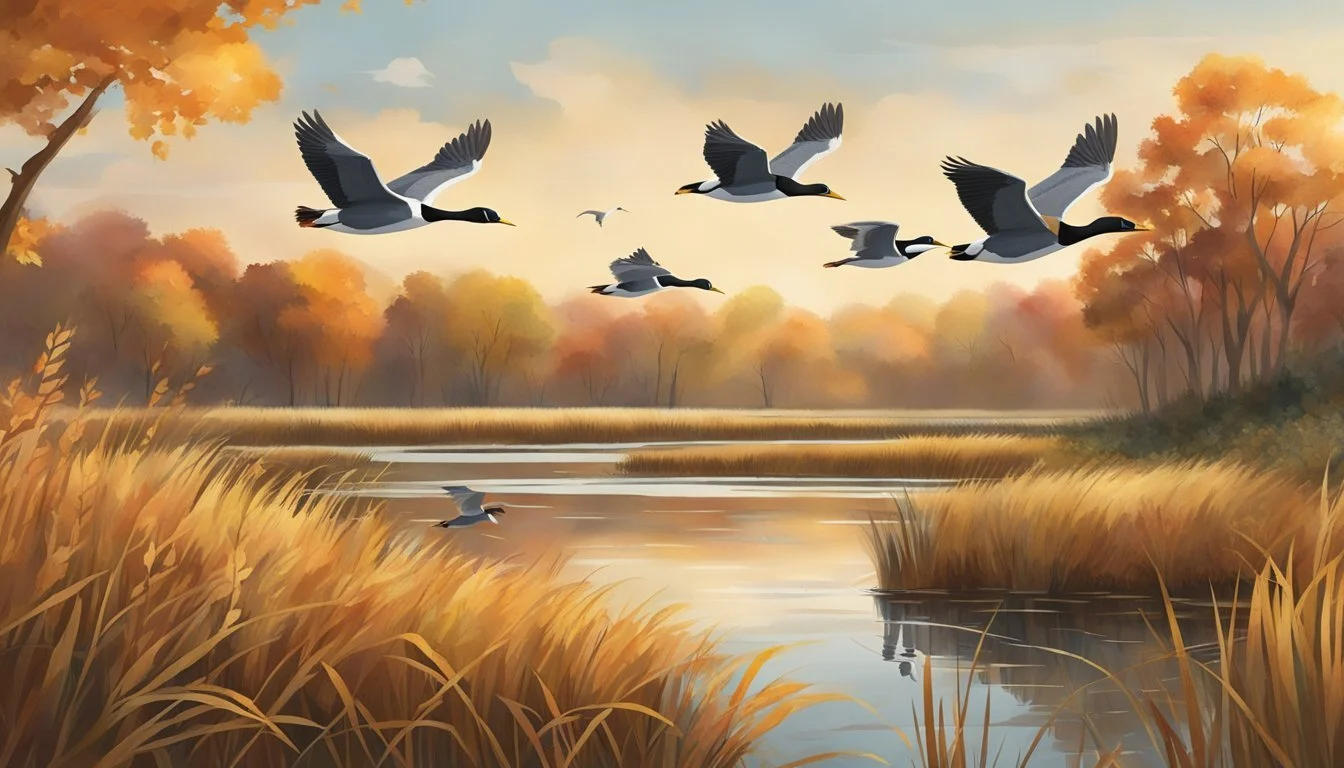Waterfowl Hunting Seasons
Essential Dates and Regulations
This Article is Part of Our Guide on Hunting Seasons for Over 70 Common Game Species
Waterfowl hunting is a regulated activity in North America, with both the United States and Canada providing structured hunting seasons that are determined by careful wildlife management and conservation efforts. These seasons are primarily set within a federal framework, which takes into account the migratory patterns of birds, the necessity to maintain healthy populations, and the preservation of their habitats. The U.S. Fish and Wildlife Service, along with its Canadian counterparts, enforces federal regulations to ensure the sustainability of hunting practices.
Each hunting season is tailored to allow hunters to engage in the tradition of waterfowl hunting while ensuring that the populations of ducks, geese, swans, and other migratory birds are not adversely impacted. Natural vegetation and wetlands are essential for the healthy breeding and feeding of waterfowl; hence, the management of these habitats is integral to conservation strategies. Licenses and permits are required to hunt waterfowl, ensuring that hunters comply with legal parameters that include specified hunting periods, bag limits, and other guidelines that may vary by geographic zones within each country.
Public input is a crucial component of the waterfowl management process, with hunters and conservationists often involved in consultations that inform the setting of hunting seasons. The regulations are reviewed and updated on a regular basis to reflect the latest scientific data and public feedback. This ongoing process allows for adaptive management of waterfowl populations, providing a balance between the hunter's pursuit and the necessary conservation measures to protect these migratory species for future generations.
Overview of Waterfowl Hunting Seasons
Regulating waterfowl hunting seasons is crucial to ensure the continuity of species while providing recreational opportunities. Hunting regulations are designed based on thorough research to balance ecological needs and hunters' interests.
Importance of Regulating Seasons
Regulating waterfowl hunting seasons is essential for the conservation of these migratory birds. Hunting seasons and regulations are established to control the hunting pressure on different waterfowl species ensuring their populations remain sustainable. It enables waterfowl to complete important life cycle events such as migration and breeding. Regulations typically include specified seasons, bag limits, and permissible hunting methods. They also serve to prevent the overharvesting of waterfowl, contributing to the long-term health of wetland ecosystems.
Determination of Hunting Seasons
The process of determining waterfowl hunting seasons is a collaborative effort among federal and state wildlife agencies. They rely on scientific data including population surveys, habitat conditions, and migration patterns. Each state may adjust its specific hunting seasons within the framework provided by federal guidelines, which are largely influenced by the Migratory Bird Treaty Act. These seasons are designed to occur when waterfowl populations can sustain a regulated level of harvest. Local authorities publish annual hunting regulations that hunters must adhere to, including:
Season Dates: The exact opening and closing dates for waterfowl hunting.
Bag Limits: The maximum number of birds a hunter may harvest per day.
Hunting Zones: Geographical divisions within a state where different regulations may apply.
Regular reviews and updates to these regulations ensure they remain effective and relevant to the current status of waterfowl populations and environmental conditions.
Legal Requirements for Hunters
Waterfowl hunting in the United States is regulated to ensure the conservation of migratory bird populations and to provide equitable hunting opportunities. Compliance with federal and state laws is mandatory, and understanding these requirements is essential for all waterfowl hunters.
Hunting License and Endorsements
Every waterfowl hunter must possess a valid state hunting license for the state in which they are hunting. Additional state-specific endorsements or permits may be required, particularly when hunting in designated wildlife management areas. Hunters should verify their state's regulations before the hunting season begins.
Migratory Bird Treaty Act Compliance
The Migratory Bird Treaty Act (MBTA) protects waterfowl and other migratory birds in the United States. Hunters must adhere to regulations set forth by the MBTA, which prohibits activities such as capturing, selling, or killing migratory birds outside of regulated hunting seasons and without proper authorization.
Harvest Information Program (HIP) and Federal Duck Stamp
Waterfowl hunters must register with the Harvest Information Program (HIP) and carry proof of registration when hunting. Furthermore, hunters aged 16 and older are required to purchase and sign a Federal Duck Stamp. This stamp must be carried on the person while hunting. Proceeds from the stamp contribute to waterfowl conservation efforts.
HIP: Provides data for monitoring waterfowl harvests
Federal Duck Stamp: Mandatory for waterfowl hunting; must be signed in ink
Usage of Non-Toxic Shot
The use of non-toxic shot is mandated for waterfowl hunting to prevent lead poisoning in both waterfowl and their habitats. Lead shot is prohibited; alternatives include steel, bismuth, or tungsten-based shot. Hunters must ensure their shotguns are plugged to limit firing to three rounds before reloading.
Non-toxic shot required: Steel, bismuth, tungsten, etc.
Shotgun capacity: Must be limited to three rounds (includes one in the chamber)
Species and Bag Limits
In setting species-specific regulations, agencies aim to sustain waterfowl populations while offering hunting opportunities. These limits are often more restrictive for certain species to ensure conservation.
Duck Limitations
Duck hunters need to be aware that daily bag limits specify the maximum number of ducks they can harvest in a single day. Within these daily limits, there may be further restrictions for specific species.
Mallards: Typically, the daily limit may include a certain number of hen mallards, often restricted to 2 hens.
Canvasback: These often have more stringent limitations, sometimes as low as 1 or 2 birds per day.
Redheads and scaup: Limits for these species can also be set separately and can fluctuate based on annual population assessments.
Possession limits are generally set at three times the daily bag limit and apply similarly to each species.
Geese and Other Waterfowl Restrictions
When hunting geese and other waterfowl such as brant, coots, and mergansers, hunters must comply with distinctive restrictions.
Geese: In contrast to ducks, seasons for geese can extend into mid-February, with bag and possession limits varying by species and region.
Brant: These may have abbreviated seasons and more conservative bag limits due to their localized population dynamics.
Coots and Mergansers: These species also have their own set of limits, which are typically separate from ducks and geese.
For all waterfowl species, hunters should confirm regulations with their local wildlife agency as seasons and limits can vary by state and are subject to change based on ongoing conservation efforts.
Seasonal Timeframes and Shooting Hours
Waterfowl hunting regulations are crafted to ensure both sustainable wildlife populations and responsible hunting practices. Seasonal timeframes and precise shooting hours are central to these regulations, and hunters are expected to adhere strictly to these windows.
Regular Season Dates
Ducks: The regular season typically spans from late September to the end of January.
Geese: A slightly extended season pushes into mid-February for geese in some areas.
For specific dates, one should always refer to local regulations as they can vary by region and species.
Early and Late Season Restrictions
Early Season: Dates often precede the regular season, focusing on specific species with individual limits.
Late Season: Runs from January 16 to April 15, accommodating specific hunting opportunities outside of the regular seasons.
These special seasons have additional restrictions to protect migrating and breeding populations during sensitive times.
Shooting Hours Explanation
The lawful shooting hours for waterfowl typically extend from one-half hour before sunrise to sunset. This is a standard practice across various regions, though there may be exceptions for certain species and periods such as:
Canada Geese: Modifications during September
Snow Geese: Possible extended hours due to conservation measures
Seasonal exceptions are detailed in individual state or regional guidelines.
Waterfowl Hunting Zones and Areas
Waterfowl hunting in the United States is managed through a system of designated zones and areas, each with specific rules and restrictions to enhance conservation efforts and regulate hunting activities effectively.
Geographical Zoning for Hunting
Northeastern Zone: This zone typically encompasses the northeastern states, where waterfowl hunting seasons are specifically tailored to migration patterns. Key areas may include habitats along the Atlantic Flyway, used by various migratory birds.
Western Zone: Spanning the western states, this zone's hunting seasons are set to coincide with the Pacific Flyway. Special attention is paid to the Southern San Joaquin Valley Zone and the Balance of State Zone, where hunters can find a blend of local and migratory waterfowl species.
Colorado River Zone: Situated along the Colorado River, this area offers unique hunting opportunities due to its position between different migratory routes.
North Coast & Klamath Basin: These areas are critical for waterfowl due to their rich wetland ecosystems. Hunters in these zones must adhere to strict season dates to protect local and migratory populations.
Waterfowl Zone Map: Hunters can refer to the official waterfowl zone maps provided by state departments, such as the California Department of Fish and Wildlife, for a detailed view of all zones and respective boundaries.
Special Management Areas and Restrictions
Humboldt Bay South Spit: As a key habitat for waterfowl, this area may have special hunting restrictions to ensure sustainable use of the environment.
Special Management Areas: Certain regions may be designated as Special Management Areas, implementing particular regulations that may restrict hunting practices or alter season dates, protecting vulnerable species during critical times of the year.
Restrictions: Hunters must be aware of restrictions that apply in these areas, which often relate to the presence of seed or grain in agricultural settings, as only naturally scattered feed can be present for hunting to be legally permissible. These restrictions are vital for preventing baiting and maintaining ethical hunting practices.
Species-Specific Seasons and Regulations
Regulations for hunting migratory waterfowl are precisely defined for various species, setting distinct seasons and bag limits to ensure sustainable harvests. There are particular rules for Canada geese, Snow and Ross' geese, and other migratory game birds.
Canada Goose Season
The Canada Goose Season typically runs from the end of September through mid-February, with the Migratory Bird Treaty Act (MBTA) placing a cap on the season length at 107 days. Restrictions vary by state, and hunters are advised to check local regulations for specific dates.
Snow Geese and Ross' Geese Regulations
Snow Geese and Ross' Geese have special regulations due to their overabundant populations. Conservation orders allow extended hunting seasons for these species in many regions, often extending outside the regular waterfowl seasons. Extended seasons might include relaxed bag limits in an effort to manage and reduce population numbers.
Other Migratory Game Birds Seasons
The hunting seasons for other migratory game birds, such as ducks, coots, mergansers, and snipe, are regulated to fall within a framework that prohibits hunting outside of periods established by the MBTA and state agencies. Rails, woodcock, and moorhens typically have designated seasons that can be found in state-specific regulations. Practices like Youth Days offer additional days for Junior Hunters to partake in waterfowl hunting under set terms. For more uncommon species like swans and cranes, seasons may be highly restrictive or closed, due to conservation status and specific state regulations.
Youth, Veteran, and Special Hunts
Across various states, designated hunting days provide unique opportunities for young hunters, veterans, and military personnel to engage in waterfowl hunting traditions. These special events are designed with regulatory support to foster the next generation of conservationists and to honor those who serve.
Designated Youth Waterfowl Hunt Days
Maryland and Alabama have set aside specific dates for youth waterfowl hunt days. The timing of such events typically falls at the beginning and towards the end of the season, allowing junior hunters the chance to hunt ducks, geese, and other waterfowl without competing against the regular hunting populous. For example, Maryland’s Department of Natural Resources has scheduled November 4, 2023, and February 3, 2024, as their youth days, whereas Alabama's Wildlife and Freshwater Fisheries Division designated November 19, 2022, for the same purpose.
Youth hunters must usually be 17 years of age or younger and are often required to be accompanied by an adult. This adult may not hunt if they do not qualify under the special hunting status, unless other seasons are open. Participating youth are encouraged to understand and follow the Hunting Information Program (HIP) requirements when applicable.
Opportunities for Veterans and Other Groups
Veterans and active-duty military personnel, including members of the National Guard and Reserves, are honored through special hunts catered to their involvement. These events coincide with the days designated for youth hunts or may be separately scheduled. Such initiatives not only provide veterans with a chance to engage in the sport but also to connect with their community and nature.
The rules for these days are specific; for instance, a veteran can partake in hunting waterfowl like ducks and white-fronted geese if they fall within the definitions stipulated by the state or the Department of Veterans Affairs. Each state's wildlife management department often releases detailed information on these hunting opportunities, including licensing and HIP compliance where relevant.
Conservation and Sustainable Practices
Waterfowl hunting, when practiced responsibly, plays a significant role in conservation efforts and ensuring the sustainability of waterfowl populations. This section explores how regulated hunting supports these objectives.
Hunting as a Tool for Conservation
Regulated waterfowl hunting provides invaluable data to conservation scientists. Hunters contribute to monitoring efforts by reporting the number and species of birds harvested. This data assists in making informed decisions about conservation strategies and hunting regulations. These regulations are designed to safeguard various flyways—the paths used by migratory birds—which are essential for the birds' survival during their seasonal movements.
States and conservation organizations often work together to use hunting as a tool to manage habitat. The funds from hunting licenses and federal duck stamps directly finance the conservation of important waterfowl habitats. These efforts prevent habitat loss and promote the restoration of areas that are critical for feeding, breeding, and migration.
Maintaining Waterfowl Populations
Effective waterfowl management is crucial to maintain healthy bird populations and to ensure that they can thrive in their natural habitats. Biological and environmental research guides the establishment of hunting seasons and bag limits. For example:
Duck Seasons: Typically run from the end of September to the end of January.
Geese Seasons: Generally extend to mid-February.
These frameworks are determined by the Migratory Bird Treaty Act (MBTA) which sets restrictions to prevent over-hunting, ensuring that waterfowl can be enjoyed by future generations. The sustainable harvest rates are calculated using banding data, and these rates help to ensure that waterfowl numbers remain stable.
By maintaining an ecological balance and supporting habitat preservation, sustainable waterfowl hunting is instrumental in protecting these valuable species and their environments.

